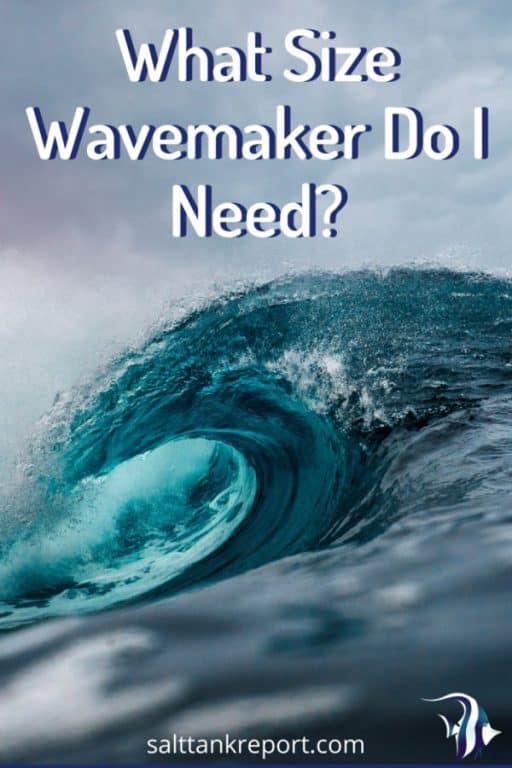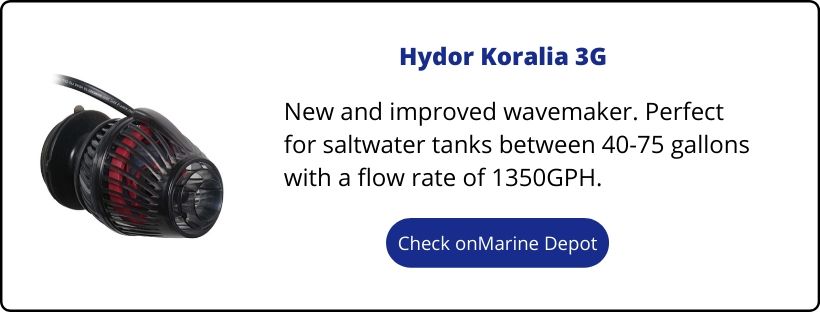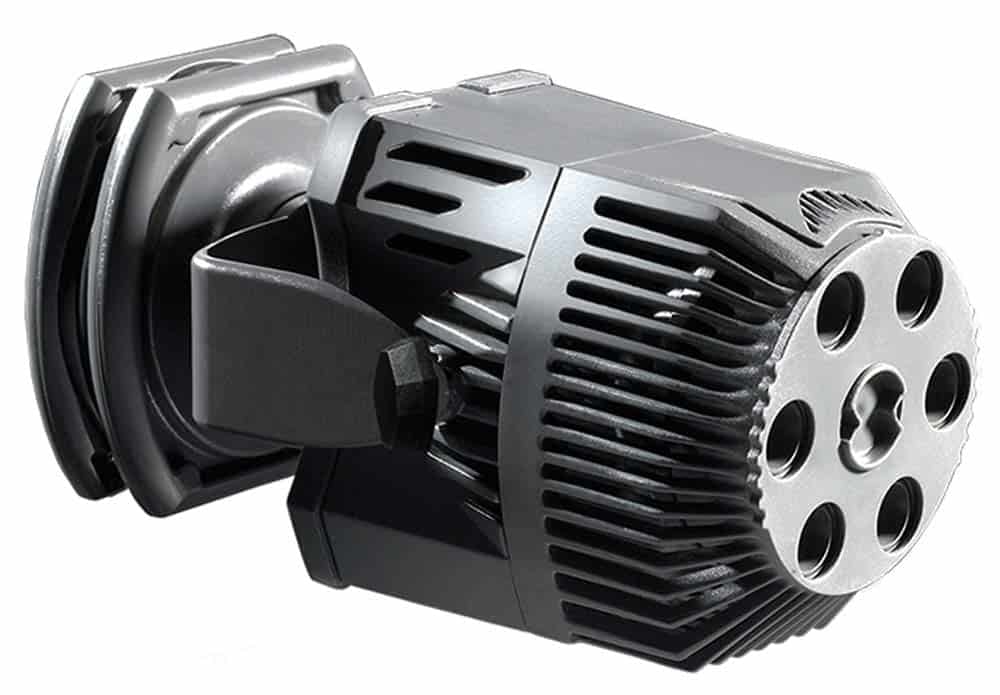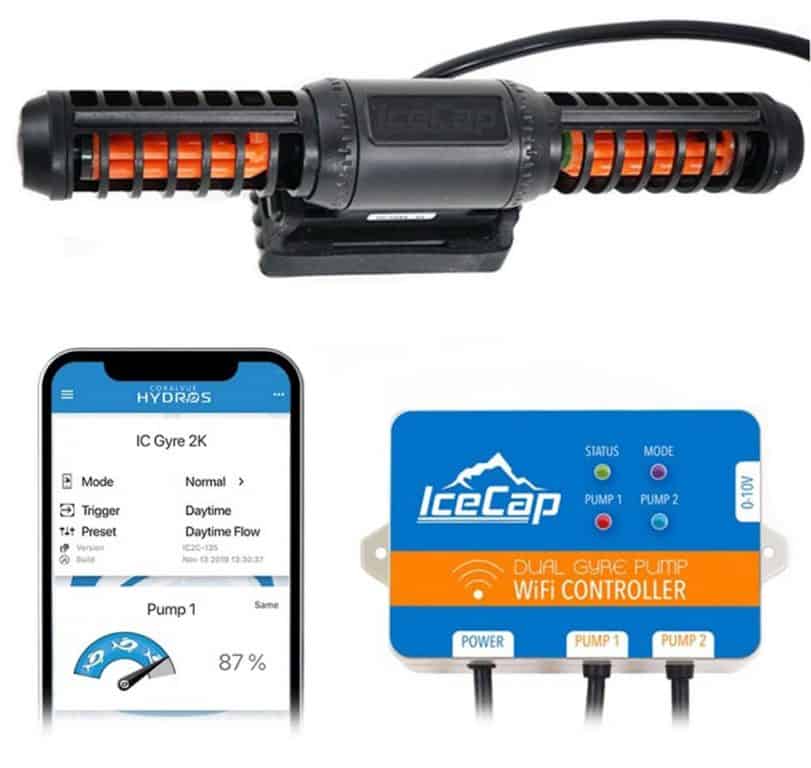
What Size Aquarium Wavemaker Do I Need?
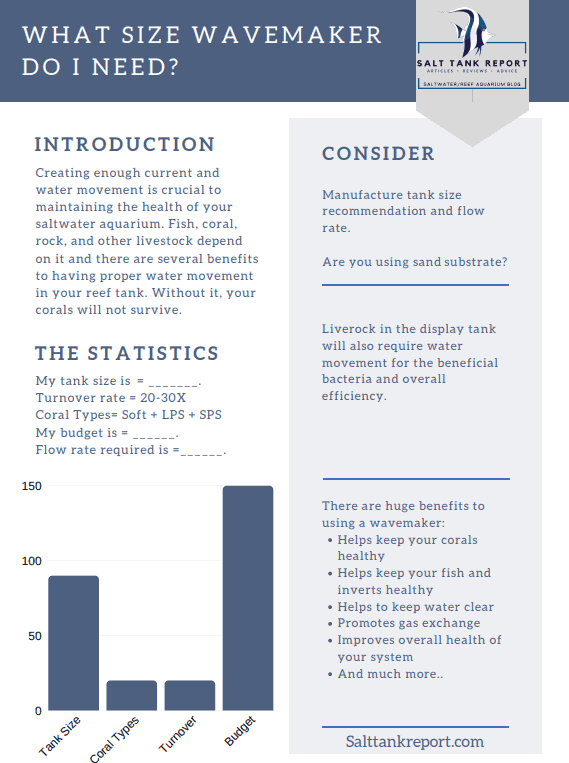

This is the ultimate guide to choosing the right size aquarium wavemaker for your saltwater tank.
You might also want to check the best affordable wavemakers for a saltwater aquarium.
In this comprehensive guide I will cover:
- How to choose a wavemaker
- Types of wavemakers
- Wavemaker size vs tank size
- Wavemaker maintenance
- And much more
Creating enough current and water movement is crucial to maintaining the health of your saltwater aquarium. Fish, coral, rock, and other livestock depend on it and there are several benefits to having proper water movement in your reef tank. Without it, your corals will not survive.
Water flow promotes gas exchange, which increases oxygen and decreases carbon dioxide. Corals will appreciate water flow to keep their tissues healthy allowing them to grow and maintain vibrant colors.
They also depend on it for bringing them food like phytoplankton and zooplankton to catch with their polyps. Water flow will also remove and clean waste from within and around the corals.
Liverock is going to play a huge role in the overall health of your tank. It holds most of the beneficial bacteria that your tank needs. The more porous the rock is the better. The porous surface of live rock will contain millions of bacteria that will break down ammonia, nitrite, and nitrate keeping it cycled.
How To Choose The Right Size Wavemaker
The manufacturer of the wavemaker will give a maximum tank size rating and flow rates. Use this as a guide and take it into consideration. But there are a few more things you will need to consider:
How much water flow do you need?
Well, that will depend on a few different factors. What do you plan to have in your tank for livestock? Certain corals like softies will only require low flow, LPS corals prefer low-medium flow, and SPS corals will do better with high water flow rates.
Certain fish also prefer different flow rates. For example, a Copperband Butterflyfish prefers to have low water movement whereas Clown Tangs prefer high water movement.
You will often hear the term turnover rate being used when determining water flow in your tank. This is basically a number given to the number of times your main water volume will be cycled or turned over in your tank. A general rule of thumb to aim for is a 20-30x turnover rate for the water volume in your tank. For example, if you have a 100-gallon reef aquarium with LPS corals, aim to have your water turnover at least 2000-3000GPH. If you are keeping SPS corals, you may need to increase this number.
What is your aquarium size?
The size of the aquarium will also play a role in determining the size of the wavemaker. Larger tanks will likely require multiple wavemakers where smaller tanks may only need one. In our example above, a 100-gallon tank that is 5 or 6 feet long will need 2 wavemakers placed on each side of the tank that equals your desired turnover rate.
You can have both wavemakers that are rated for 1000+ GPH each. This will allow you to position them in different locations and get better water movement eliminating dead spots in your tank. Multiple smaller units are better than one larger one.
A smaller tank will usually only require one wavemaker. Although you can still have multiples. If you have a 30-gallon tank and aim for a 20X turnover rate, you will only need a wavemaker rated for 600GPH. One unit like the new Jebao SLP-10 wavemaker is more than suitable in this case.
What do you use for the substrate in your tank?
If you are using a fine sand that will blow around easily, then you will need to choose a wavemaker that isn’t so strong to blow the sand all around the tank. Some people who have more demanding corals like SPS will require a high flow rate. Therefore it’s common to see these tanks with bare bottom glass instead of sand just for this reason.
Do you really need a wavemaker for saltwater tanks?
The answer to this question is it depends. I know, I can’t stand it when people answer with “it depends”. But in this case, it really does depend on what you plan to keep in your saltwater tank for livestock.
If you are keeping a fish only tank, you can get away without a wavemaker if you have other methods of turning over the water in the tank.
You can use a hang on filter, internal filter, or canister filter which will provide some water movement. Wavemakers also play an important role in removing detritus from your tank.
Instead of the detritus clumping up in the corner of your tank, a wavemaker will help keep it moving in order for the filtration to get rid of it.
Many people with bare bottom tanks will use strong water flow to keep the bottom glass clean and free of detritus.
But of course, if you are keeping fish and corals that require water movement, then yes you need to have one or more wavemakers in the tank. Liverock in the display tank will also require water movement for the beneficial bacteria and overall efficiency.
Check out: Best affordable wavemakers for a saltwater aquarium
How many wavemakers do I need?
As mentioned, larger tanks may require more than one wavemaker. Not only is it more beneficial to have multiples, but it gives you a backup if one were to fail. It’s great to have a backup. Smaller nano tanks may only need one wavemaker.
It’s common for very large saltwater tanks to have several powerful wavemakers. For example, a 500-gallon tank that is 8 feet long will need plenty of water current and may use 6-8 large pumps to produce enough current.
Types Of Wavemakers To Choose From
You will have 2 options to choose from:
- AC wavemakers
- DC wavemakers
AC wavemakers are the older technology plug and play systems. They are very basic just plug them into the outlet to turn on and unplug to turn off. Nothing fancy and they don’t have any special features.
There are several brands of AC wavemakers on the market and typically these will cost less than the newer DC models. A problem with this type is the larger wavemakers are normally louder when operating which I can’t stand.
I like my wavemakers to be silent!
An example of a great AC wavemaker is the Hydor Koralia 3G. This model is improved over previous versions and is very reliable and affordable.
DC wavemakers are much newer technology and have plenty of great features and advantages. They don’t use as much power to operate them which is a huge bonus if you have a large tank.
They are generally more powerful than the AC units and are very quiet. They can also be used with controllers which can be used to program different settings and wave modes.
The newer wavemakers on the market today are very well built with some amazing features. You can even program them through your smartphones!
An example of a great DC wave maker is the Orlushy DC12000. These pumps are known for their reliability and quality design.
How To Reduce Flow On Aquarium Wavemakers
If you have a basic AC wavemaker like the Koralia above, you won’t be able to control the flow rate. These pumps are designed to push a constant amount of water without pulsing or changing flow rates. There is no built-in option for reducing the flow.
Some AC wavemakers and powerheads like the Sicce Voyager 3, have a manual flow control by adjusting a dial on the front of the unit which will allow more or less water through it.
If you have a DC wavemaker, then controlling the flow rates will be easy. You can reduce the flow by using the included controller.
The new IceCap Gyre 2K is a great example. This includes a wifi controller which you can use to reduce or increase the flow as required by using your smartphone.
Should I leave the wavemaker on all the time?
This is a question that depends on your tank’s requirements and your personal preference. If you only use AC powered wavemakers that are not controllable, then yes you should leave them running 24/7 as you don’t have the option to reduce the flow at night.
If you are using DC-powered wavemakers that are controllable, you will have the option to reduce the flow at certain times if you don’t want to run them all the time. You can set a schedule to have them operate at a reduced setting at certain times.
You should never turn your wavemakers completely off. Your saltwater tank requires proper flow at all times. Some people who have a sump system turn off their wavemakers at night and just use the return pump for water flow in the tank. This is not a good idea!
Your wavemakers do not need to operate at the same flow all the time. There are benefits to having them ramp up and down at specific times.
So yes, you can leave the wavemaker on all the time. There is no harm in doing so.
Wavemaker size vs tank size
Where should you install the wavemakers in your tank?
Most wavemakers are installed either on the side glass or acrylic panels of your tank. This is a common location. You can also position them on the back wall. If you have multiple wavemakers in your tank, you can position them at different height levels and flow rates to create various flow patterns.
If you have some high demand corals like SPS, they will need more water flow than others. You may need to position a wavemaker in a location that provides additional flow to these corals.
With larger tanks, it’s common to see several wavemakers positioned on each side panel and along with the back wall panel. This allows for plenty of water movement and turnover rate eliminating dead zones.
There is no specific rule with respect to positioning. Determine the flow rate that you need for your tank and decide on the types of wavemaker and quantity you need.
Depending on the type of wavemaker you have, you can have the option to mount them with suction cups or magnets. Most of the wavemakers designed today have strong quality magnets that will hold your pump in place. Normally there will be a manufacturer’s rating given for glass thickness in order for the magnet to hold properly.
How many wavemakers do you need for a 40-gallon tank?
Most 40 gallon tanks are either 3 or 4 feet long. For that sized tank, if using the 20-30X turnover rate rule of thumb, then you should aim to have either 1 wavemaker capable of producing 800-1200 GPH. You can also choose to have 2 wavemakers positioned on each end of the tank that produces 400-600 GPH each.
A 40-gallon tank size really only needs 1 wavemaker but you can have 2 if you want a more diverse flow pattern.
What size wavemaker do you need for a 120-gallon tank?
Again using our rule of thumb of 20-30X turn over rate, aim to have a wavemaker that is capable of producing 2400-3600 GPH. A 120-gallon aquarium is normally 5 or 6 feet long so you need something that is strong and creates current the full length of the tank.
In an aquarium of this size, you should aim to have multiple wavemakers.
Wavemakers vs powerheads – What’s the difference?
Both of these items are designed to move water in your tank. The difference is that a powerhead is designed to move a smaller portion of the water like a stream. They don’t really create waves or move a large portion of water as a wavemaker does. The Koralia Evolution is a commonly used powerhead that is reliable and affordable.
The wavemaker is designed to move a larger body of water forward and back. Producing a wave of water in your tank. Wavemakers can be very effective in small or large tanks creating realistic ocean waves. Many wavemakers have built-in features like pulse modes, reef crests, reverse. The Maxspect Gyre is a great quality wavemaker that pushes a ton of water!
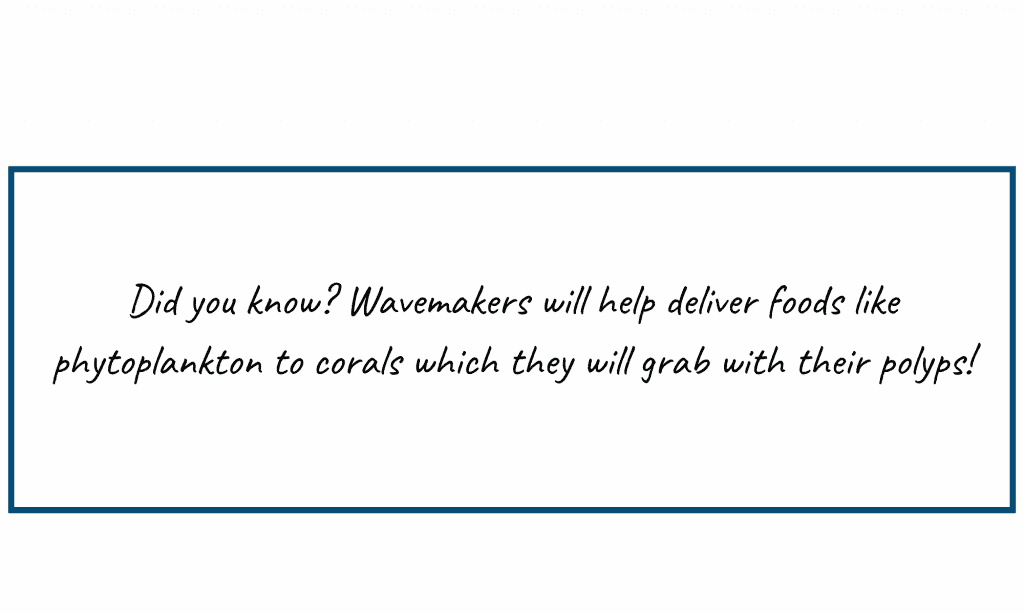

Wavemakers for small nano tanks
If you have a smaller nano tank, there are many options available for you as well. Small tanks don’t require as much water movement as the larger tanks and there are some really great wavemakers and powerheads available on the market. If you have a small 10-gallon aquarium, you can use something like the Jebao SW-2 or the Koralia nano.
Wavemaker maintenance and cleaning
When you are choosing the proper size wavemaker for your tank, take into consideration the maintenance and cleaning that is required. If you have a larger tank, you will need more wavemakers that are most likely larger and will require more effort to be cleaned and maintained on a regular basis.
Smaller tanks and smaller wavemakers do not require as much effort. Although it’s not a huge concern, it’s just worth mentioning as your wavemakers will fail over time if they are not cared for properly. It doesn’t take long for algae to form on them and they will need to be disassembled and cleaned regularly.
Some people prefer less maintenance and therefore settle with a smaller sized tank and wavemaker.
You can read more about wavemakers and powerheads in this article.
